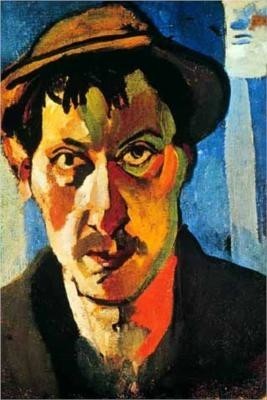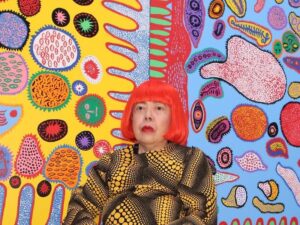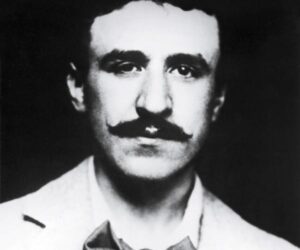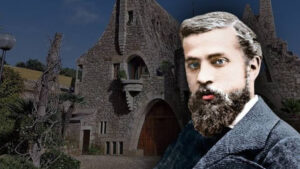André Derain- Introduction
André Derain was known for/as Camillo Academy, Julian Academy (French sculptor, painter, artist and co-founder of Fauvism). The birthplace of this artist is Chatou, Yvelines, Ile-de-France, France. And this artist is the supporter of Fauvism because every painting of this artist shows the style of Fauvism art movement. Paintings such as “Estaque” and “Portrait of Matisse,” are some famous paintings of this artist. This article covers essential sections- Towards a new classicism, Fauvism & The Last Supper, 1911.
We become intoxicated with color, with words that speak of color, and with the sun that makes colors brighter.
André Derain
André Derain- Biography
André Derain’s biography is a fascinating journey marked by artistic exploration and evolution. Transitioning from his early years in Chatou, France, Derain’s passion for art was evident from a young age. His studies at the Académie Carrière in Paris provided a solid foundation, and his interactions with fellow artists like Henri Matisse and Maurice de Vlaminck sparked a revolutionary artistic movement known as Fauvism.
During his Fauvist period, Derain’s bold use of vibrant colors and expressive brushwork set him apart as a leading figure in the avant-garde art scene. However, as the years passed, Derain’s style underwent a significant transformation. He began exploring classicism and traditional techniques, demonstrating his versatility as an artist.

Throughout his life, Derain’s artistic journey took him to various locations, including London and the Mediterranean coast, where he found inspiration in the landscapes and cultures. His travels enriched his artistic language, and his works reflected an amalgamation of different influences.
André Derain’s biography stands as a testament to the power of artistic exploration, versatility, and adaptability. His profound impact on the art world endures, securing his place as one of the pioneers of modern art.
This artist was also interested in
Frequently asked questions
1. Why are André Derain paintings so costly?
The paintings of André Derain remains in high demand, lovers like to purchase the painting of this artist. Following are some artworks of this artist.
- “Estaque”
- “Portrait of Matisse”
- “Landscape near Chatou”
You can search these artworks of these Fauvism artists on- Artplode ( artwork), Artfinder (Fauvism paintings), Saatchi Art, Society6, and Artnet.
2. If I want to compare the artwork of this Fauvism artist, then whom should be compared with André Derain?
There are so many artists of Fauvism. Perhaps, you may disagree with our comparison if you are an ardent follower of this artist. But in view of the area of activity such as Camillo Academy, Julian Academy (French sculptor, painter, artist and co-founder of Fauvism). We suggest you compare the artworks of his with the following artists:
- Andy Goldsworthy
- Angelica Kauffman
- Anni Albers
- Andy Goldsworthy
- Bridget Riley
André Derain- Early years
In the early years of André Derain, a prominent figure in the Fauvist movement, several formative experiences shaped his artistic journey. Transitioning from his childhood in Chatou, France, Derain’s initial exposure to art came through his close friendship with Henri Matisse while studying at the Académie Camillo. This pivotal connection sparked his interest in painting and fostered a mutual exchange of creative ideas.
Derain’s travels to London and the Mediterranean region further enriched his artistic development. These journeys exposed him to new landscapes, light, and colors, influencing his vibrant and bold approach to painting. The Fauvist movement, characterized by its expressive use of color, captivated Derain, leading him to experiment with intense hues and brushwork.
During this period, Derain’s collaboration with fellow Fauvist, André Marquet, further deepened his artistic exploration. Their artistic camaraderie facilitated the exchange of techniques and concepts, contributing to the evolution of their respective styles.
In conclusion, the early years of André Derain were marked by formative friendships, diverse travels, and an immersion in the Fauvist movement, all of which laid the foundation for his remarkable artistic career.
André Derain- Fauvism
André Derain’s Fauvism was a transformative movement that left an indelible mark on the art world. Transitioning from traditional artistic conventions, Fauvism emerged as a bold and vibrant style characterized by its intense colors and spontaneous brushwork. Derain, along with Henri Matisse, pioneered this movement, challenging the prevailing norms of representation.
Influenced by the bold use of color by the Post-Impressionists and tribal art, Fauvism embraced a non-realist approach, prioritizing emotional expression over accuracy. Derain’s unique ability to juxtapose vivid hues in unexpected ways created a sense of dynamism and energy in his paintings.
With a focus on capturing the essence of a subject rather than its literal depiction, Fauvism encouraged a subjective interpretation of reality. This revolutionary approach laid the foundation for future developments in modern art, influencing the birth of Expressionism and even some elements of Cubism.
Derain’s contributions to Fauvism extended beyond painting; he also ventured into sculpture and printmaking, showcasing his versatility and innovation as an artist. His daring exploration of color and form inspired a new generation of artists, ensuring Fauvism’s lasting impact on the trajectory of art history.
André Derain- Towards a new classicism
Towards a new classicism, André Derain embarked on a transformative artistic journey that left an indelible mark on the art world. Transitioning from his early Fauvist period, Derain’s quest for a more structured and ordered style led him to explore the realms of classicism. Embracing a return to the classical values of balance, proportion, and harmony, he sought to infuse his work with a sense of timeless beauty.
During this phase, Derain’s art displayed a deliberate departure from the vibrant colors and wild brushstrokes of Fauvism. Instead, he employed a more restrained palette and refined technique to achieve a sense of balance and formality in his compositions.
Influenced by the works of the Old Masters and his fascination with ancient art, Derain’s paintings exuded a sense of classical grandeur while retaining a modern sensibility. His compositions often featured mythological themes and allegorical subjects, showcasing his mastery of both tradition and innovation.
So Derain’s exploration of a new classicism exemplified his artistic versatility and willingness to push boundaries. It showcased his profound understanding of art history while simultaneously contributing to the development of new artistic paradigms. Also his pursuit of a timeless aesthetic continues to inspire artists and art enthusiasts, leaving an enduring legacy in the annals of art history.
Know everything about André Derain in short
André Derain- Information through Questions
In this article, you got the answer of following questions- Frequently asked questions:-
- Who is André Derain and why this artist is so famous?
- What are the notable artworks of André Derain?
- What are André Derain most famous artworks of? And why, these are so costly?
- What are some interesting facts about André Derain?
- What are the most important sections of the life of André Derain which anybody should know?
You knew about the most important section of the life of André Derain, how the artistic career starts from the first part and ends at the second part. These important sections are:- Towards a new classicism, Fauvism & The Last Supper, 1911 You read almost everything about this artist (André Derain). But still, if you want to read more about Fauvism and André Derain then you may read the following articles:-
- André Derain – Biography | short notes | Top artworks.
- André Derain – Life, paintings, contribution, death.
- André Derain – Short notes | Know everything in seconds.
- André Derain – Facts, Overview, complete life- At a glance.
These articles cover the whole artistic journey of this artist comprehensively.
Exhibition list
Exhibition list of André Derain:
- Co-founder of Fauvism, showcased in groundbreaking exhibitions with Matisse and de Vlaminck.
- Solo exhibitions highlighted his unique style and artistic vision.
- Garnered critical acclaim for innovative approach to painting.
- Participated in group exhibitions like Salon d’Automne and Salon des Indépendants.
- Solidified reputation as a leading avant-garde artist.
- Engaged with a wider audience and contributed to artistic dialogue.
- International exhibitions in Europe and the United States.
- Increased global influence and prominence in modern art.
- Artworks displayed in prestigious galleries and museums.
- Captivated art enthusiasts worldwide.
- Evolving exhibition history from Fauvist roots to a pioneering artist of the 20th century.
- Testament to groundbreaking contributions to modern art.




